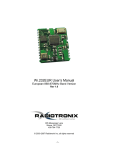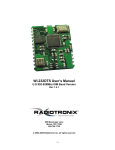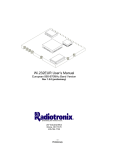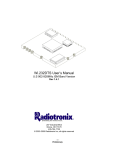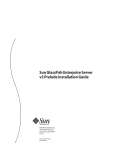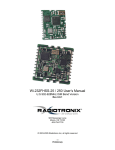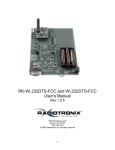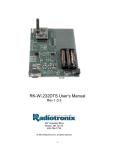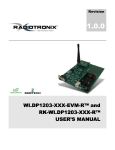Download Advantage-Devices Wi232 User`s manual
Transcript
Wi.232DTS User’s Manual Rev 1.0 Embedding the wireless 207 Industrial Blvd Moore, OK 73170 405-794-7730 © 2002 Radiotronix Inc, all rights reserved -i– Preliminary 1. Document Control Steve Montgomery Created By 12/9/03 Engineering Review Marketing Review Approved Engineering Approved - Marketing Revision 1.0 1.1 Author SJM SJM Date 12/9/03 12/11/03 Description Document Created -Updated DATARATE table to include 38.4kbit/sec -Corrected 4.10 – CMD should be held high to force factory defaults after reset - ii – Preliminary 2. Introduction Module Overview TRANSMITTER BASEBAND DSP ANTENNA SWITCH COMBINER UART CONTROL ANTENNA VCO PROTOCOL CONTROLLER 2.1. ANALOG IN DIGITAL I/O DATA RECEIVER LEGEND HARDWARE IN WISE Wi.232 APPLICATION SOFTWARE IN WISE WiSE MAC SERIAL INTERFACE WiSE PACKET I/O INTERFACE HAL Figure 1: Wi.232DTS Block Diagram 2.2. • • • • • • • • • Features True UART to antenna solution 16-bit CRC error checking Data encryption/encoding for PGP 152.34kbit/sec maximum RF data rate 32 channels in DTS mode 84 channels in low-power mode Small size – .8” x .935” .08” Low power active standby mode PHY and MAC layer protocol built in 2.3. • • • • • • • • CSMA medium access control Channel QOS indicator 114dB link budget in DTS mode 2 mode allow user to optimize power/range Command mode 48-bit unique MAC address 5 volt tolerant I/O Under $20 in production quantities Applications • Direct RS-232/422/485 wire replacement • Industrial/Home Automation • • RFID Asset Tracking • • Wireless Sensors Automated Meter Reading • Remote Data Logging Wi.232DTS Preliminary © 2003 Radiotronix Inc. Preliminary 2 Preliminary Table of Contents Document Control................................................................................................................. 2 Introduction ........................................................................................................................... 2 2.1. Module Overview .............................................................................................................. 2 2.2. Features ............................................................................................................................ 2 2.3. Applications....................................................................................................................... 2 Table of Contents ............................................................................................................................ 3 Table of Figures............................................................................................................................... 3 3. Theory of Operation.............................................................................................................. 4 4. Application Information ......................................................................................................... 6 4.1. Pin-out Diagram ................................................................................................................ 6 4.2. Pin Description .................................................................................................................. 6 4.3. Mechanical Drawing.......................................................................................................... 7 4.4. Example Circuit ................................................................................................................. 8 4.5. Power Supply .................................................................................................................... 8 4.6. UART Interface ................................................................................................................. 8 4.7. Operating Mode ................................................................................................................ 9 4.7.1. DTS Mode.................................................................................................................. 9 4.7.2. Low power Mode...................................................................................................... 10 4.7.3. Active state operation .............................................................................................. 10 4.7.4. Active Standby Mode ............................................................................................... 11 4.8. Link budget, transmit power, and range performance .................................................... 12 4.9. Channel settings ............................................................................................................. 13 4.10. UART Data Rate.......................................................................................................... 13 4.11. RF Data Rate............................................................................................................... 14 4.12. Transmit Wait Timeout ................................................................................................ 14 4.13. Data Encoding ............................................................................................................. 15 4.14. QOS............................................................................................................................. 15 4.15. Programming Registers............................................................................................... 15 4.16. Antenna ....................................................................................................................... 17 5. Electrical Specifications ...................................................................................................... 18 5.1. Absolute Maximum Ratings ............................................................................................ 18 5.2. Detailed Electrical Specifications .................................................................................... 18 5.2.1. AC Specifications – RX............................................................................................ 18 5.2.2. AC Specifications – TX ............................................................................................ 19 5.2.3. DC Specifications..................................................................................................... 19 6. Custom Applications ........................................................................................................... 19 7. Ordering Information........................................................................................................... 20 8. Contact Us .......................................................................................................................... 20 8.1. Technical Support ........................................................................................................... 20 8.2. Sales Support.................................................................................................................. 20 1. 2. Table of Figures Figure 1: Wi.232DTS Block Diagram............................................................................................... 2 Figure 3: Pin-out diagram ................................................................................................................ 6 Figure 4: Example Circuit ................................................................................................................ 8 Wi.232DTS Preliminary © 2003 Radiotronix Inc. Preliminary 3 Preliminary 3. Theory of Operation The Wi.232 module combines a state-of-the-art DTS/FSK data transceiver and a highperformance protocol controller to create a transparent UART-to-antenna wireless solution capable of direct wire replacement in any embedded application. The module is designed to interface directly to a host UART. Three signals are used to transfer data between the module and the host UART: TXD, RXD, and CTS. TXD is the data output from the module RXD is the data input to the module. CTS is an output that indicates the status of the module’s data interface. If CTS is low, the module is ready to accept data. If CTS is high, the module is busy and the host UART should not send any further data. When data transfers are small (<20 bytes) and infrequent (<1 transmission/second), the CTS line does not need to be monitored. However, if these conditions are not met, the host UART should strictly monitor the CTS line. Internally, the module has a 64 byte buffer for incoming characters from the host UART. When the buffer has reached 62 characters, the CTS line goes high, indicating to the host UART not to send any more characters. Once that buffer level is reached, the data is sent to the WiSE™ MAC layer so that it can be transmitted over the wireless link. When the first character of the input buffer is received, the module will start a timer. The timer is preloaded with the value of regTXTO and counts down once every millisecond. If that timer counts to 0 before the buffer is full, the module will send whatever is the buffer to the MAC layer for transmission. The countdown value should be set to the time it takes to send the amount of data required by the application plus 2 bytes. For example, if the application only needs to send 10 bytes of information per transmission, and the UART data rate is 1200 bits/second, the timeout should be set to 80 mSec (see section 3.12 for details on how to calculate regTXTO). Internally, two alternating buffers are used to receive incoming UART data and to transmit the data over the wireless link. Therefore, the module can continue to receive data from the UART interface even when the module is transmitting a packet. When the MAC layer has a packet to send, it will use a carrier-sense-multiple-access (CSMA) protocol to determine if another module is already transmitting. If another module is transmitting, the module will receive that data before attempting to transmit its data again. If, during this process, the UART receive buffer gets full, the CTS line will go high to prevent the host UART from over-running the receive buffer. DATA OUT Wi.232 Module Wi.232 Module DATA OUT DATA IN DATA OUT Wi.232 Module DATA OUT DATA OUT Wi.232 Module DATA OUT DATA IN Figure 2: Wi.232 Network Concept Wi.232DTS Preliminary © 2003 Radiotronix Inc. Preliminary The MAC layer prefixes the data with a packet header and postfixes the data with a 16-bit CRC. Data is encoded using a proprietary algorithm to spread the RF energy equally within the transmission bandwidth. Additionally, a 256-bit key can be used to further encrypt the data. The encryption algorithm 4 Preliminary is simple and is good for PGP. If a higher level of security is required, it is recommended that the user encrypt the data with an appropriate algorithm before it is sent to the module. When a module transmits a packet, all other modules on the same channel will receive the packet, check the packet for errors, decrypt the data if necessary, and send the error free data their host UARTs for processing. The modules only implement the ISO reference network stack up to the MAC layer, so they do not recognize any addressing schemes. Therefore, the modules can work with any link-layer and higher protocols in existing today. Certain features of the module are controlled through programmable volatile and non-volatile registers. Registers are access by bringing CMD high. When CMD is high, all data transfers from the host UART are considered to be register access commands. When CMD is low, all data transfers from the host UART are considered to be raw data that needs to be transparently transmitted across the wireless link. The UART interface is capable of operating in full duplex at baud rates from 1.2 kbit/sec to 115.2 kbit/sec. The module has three modes of operation: DTS, low-power, and active standby. The Wi.232DTS module is the first module in the world to take advantage of the DTS provision in FCC part 15 rules. Under this provision, transmitters can operate at a higher output power if the transmission bandwidth is at least 500kHz. Through an encoding technique we call DirectSPREAD™, the Wi.232DTS module is able to operate at +12dBm and meet the requirements of this provision. In DTS mode, the module’s channel bandwidth is set to 600kHz and the transmit power is set to +12dBm. In this mode, the module can operate on 32 channels and support a maximum RF data rate of 152.34kbit/second. The receiver sensitivity at the max data rate is –102dBm, yielding a link budget of 114dB. This mode is an excellent alternative to frequency hopping spread spectrum. It has very fast synchronization, allowing it to operate in a duty-cycle mode for extended battery life. In low-power mode, the module’s channel bandwidth is set to 200kHz and the transmit power is set to 0dBm. In this mode, the module can operate on 84 channels and support a maximum data rate of 38.4 kbit/second. The receiver sensitivity at the maximum data rate is –107, yielding a link budget of 107dB. This mode reduces transmit current consumption, allowing use with batteries than cannot supply the pulse currents required for DTS mode. The range in this mode will be a little less than half of the range in DTS mode. In active-standby mode, the module spends most of its time sleeping. It will wake up when there is data to transmit or when a sleep timeout has occurred. The time-out is programmable; the longer the time-out, the lower the current consumption. When the module wakes, it will be in lowpower or DTS mode, depending on the register programming. All modules in a network must have the same mode configuration to ensure interoperability. When the module is active (low-power or DTS mode), it is monitoring the receive channel for quality of service. An algorithm that monitors RSSI, packet starts, and packet errors accomplishes this. Every Wi.232 module has read-only internal registers that contain factory programmed information that includes calibration data and a 48-bit IEEE MAC address that can be used by the host application for higher level, connection oriented protocols. Wi.232DTS Preliminary © 2003 Radiotronix Inc. Preliminary 5 Preliminary 4. Application Information 4.1. Pin-out Diagram Figure 3: Pin-out diagram 4.2. No. 1 2 3 4 5 6 7 8 9 10 11 12 13 14 15 16 17 18 19 Pin Description Description Ground No connect – reserved No connect – reserved Command input – active high UART receive input UART transmit output UART clear to send output – active low No connect – reserved No connect – reserved Reserved – ISP pin Reserved – ISP pin Ground Antenna port – 50 ohm Ground Ground Ground Ground Ground VCC – 2.7 to 3.6 VDC Legend: Signals that are used in this implementation Signals not used in this implementation –do not connect Signals used for in-system programming Wi.232DTS Preliminary © 2003 Radiotronix Inc. Preliminary 6 Preliminary 4.3. Mechanical Drawing Wi.232DTS Preliminary © 2003 Radiotronix Inc. Preliminary 7 Preliminary 4.4. Example Circuit Figure 4: Example Circuit 4.5. Power Supply Although the Wi.232DTS module is very easy to use, care must be given to the design of the power supply circuit. It is important for the power supply to be free of digital noise generated by other parts of the application circuit, such as the RS-232 converter. If noise is a problem, it can usually be eliminated by using a dedicated LDO regulator for the module and/or by separating the grounds for the module and the other circuits. 4.6. UART Interface The UART interface is very simple; it is comprised of four CMOS compatible digital lines. Line Direction Description CTS Out CMD In Clear to send – this pin indicates to the host micro when it is ok to send data. When CTS is high, the host micro should stop sending data to the module until CTS returns to the low state. Command – the host micro will bring this pin high to put the module in command mode. Command mode is used to set and read the internal registers that control the operation of the module. When CMD0 is low, the module will transparently transfer data to and from other modules on the same channel. NOTE: If this pin is high when the module comes out of reset, the registers will be reset to their factory programmed defaults. It is important to ensure that Wi.232DTS Preliminary © 2003 Radiotronix Inc. Preliminary 8 Preliminary RXD TXD 4.7. CMD is held low during power-up under normal conditions. Receive data input. Transmit data output In Out Operating Mode The operating mode of the module is determined by the settings of the regMODE register. R/W SB4 7 R/W SB3 6 R/W SB2 5 R/W SB1 4 R/W SB0 3 R/W MODE 2 R/W STBY1 1 R/W STBY0 0 Bit 0-1: STBY: Standby Mode Select These bit controls the standby mode of the module. 00: The module is in sleep mode 01: The module is in active standby mode. The sleep time is controlled by SB0-SB5. When the module is awake, the mode is controlled by bit 2. 11: The module is active. The mode is controlled by bit 2. Bit 2: MODE: Active Mode Select This bit controls the active mode of the module. 0: The module is in low-power mode 1: The module is in DTS mode Bit 3-7: SB0-SB4 These bits control the sleep time in active standby mode. 00000: Duty cycle = 10:1 00001: Duty cycle = 25:1 00010: Duty cycle = 50:1 00011: Duty cycle = 100:1 00100: Duty cycle = 150:1 00101: Duty cycle = 200:1 00110: Duty cycle = 300:1 00111: Duty cycle = 400:1 01000: Duty cycle = 500:1 01001: Duty cycle = 600:1 01010: Duty cycle = 700:1 01011: Duty cycle = 800:1 01100: Duty cycle = 900:1 01101: Duty cycle = 1000:1 4.7.1. DTS Mode In DTS mode, the module is configured as follows: TX Power Deviation TX Current RX Current RX Bandwidth Wi.232DTS Preliminary +12dBm +/-235kHz 70mA 22mA 600kHz © 2003 Radiotronix Inc. Preliminary 9 Preliminary 4.7.2. Low power Mode In low-power mode, the module is configured as follows: TX Power Deviation TX Current RX Current RX Bandwidth +0dBm +/-50kHz 41mA 22mA 200kHz 4.7.3. Active state operation When the module is in DTS or low-power mode, it is active. The primary active state is the IDLE state. When the module is not actively transmitting or receiving data, it is in this state. While in this state, the receiver is enabled and the module is continuously listening for incoming data. If the module detects a pre-amble and valid start-code, it will enter the RX_HEADER state. IS R R F ER AD HE E O U T R X T IM R X H E A D E R D A TA LE N <40 B CCR AD P A C K E T Q U E D RX DO NE R X D A TA OK ID L E M O D E RF ISR C R C U A R T TX Figure 5: RX State Machine If the module is in the IDLE state and a byte is received by the UART, it will enter the TX_WAIT state. RX HEADER RF R IS T UAR 0 =4 EN L T TA OR OU E DA M I T TX TX WAIT RX IDLE MODE DATALEN<40 TE PLE COM TX CSMA Figure 6: TX State Machine Wi.232DTS Preliminary © 2003 Radiotronix Inc. Preliminary 10 Preliminary 4.7.4. Active Standby Mode In active standby mode, the module spends most of its time in sleep mode. The sleep time is programmed as a function of the minimum on time, which is a function of the data rate and state timing of the transceiver. Minimum On Time (mS) 16.0000 14.0000 12.0000 10.0000 Series1 8.0000 6.0000 4.0000 2.0000 0.0000 4800 9600 19200 38400 76800 152340 Data Rate (bit/sec) Figure 7: Minimum on time versus data rate As the data rate goes up, it contributes less to the minimum on time, giving the curve in figure 5 its shape. The minimum on time is calculated according the following formula: Ton(m sec) = 3.8 + 48 / BR *1000 The average on current is calculated by: Iavgon = 2.74e −5 + 48 / BR * 25e −3 The sleep time is figured by multiplying the on time times the duty cycle set in regMODE. The current draw in sleep mode is 21uA. Active stand-by average current consumption can then be calculated using the following formula: Istby = Ton * Iavgon + Tslp * 21e −6 Ton + Tslp The following table shows the active standby current for a data rate of 152.34kbit/sec. Wi.232DTS Preliminary © 2003 Radiotronix Inc. Preliminary 11 Preliminary Duty Cycle (X:1) 10 25 50 100 150 200 300 400 500 600 700 800 900 1000 Sleep Time (mSec) 41 103 206 412 617 823 1235 1646 2058 2469 2881 3292 3704 4115 Istby (mA) 0.789 0.346 0.187 0.105 0.077 0.063 0.049 0.042 0.038 0.035 0.033 0.032 0.030 0.029 Latency (mSec) 45 107 210 416 621 827 1239 1650 2062 2473 2885 3296 3708 4119 Active standby mode introduces latency. The transmitting module must transmit a pre-amble equal to the length of the sleep time plus the start-up time of the receiver to ensure that all of the other modules will be receiving when the transmission is sent. In effect the latency grows as the average standby current shrinks. Other than the end-to-end transmission delay, the operation in active standby mode, including the preamble transmission, is completely transparent and handled within the module. 4.8. Link budget, transmit power, and range performance A link budget is the best figure of merit for comparing wireless solutions and determining how they will perform in the field. In general, the solution with the best link budget will deliver the best line-of-sight range performance. Improving the link budget by increasing the receiver sensitivity will result in lower power consumption while improving the link budget by increasing the transmit power will result in more robust performance in the presence of an on-channel interferer or multi-path interference. MYTH REVEALED: You will never reduce the performance of a wireless link by increasing the sensitivity. It has been proposed that less sensitive receiver’s will perform better in a noisy environment. That simply is not true. It is the equivalent of saying that someone who is hard of hearing can hear better in a noisy room than in a quiet room. The real solution is to make the talker speak louder to get over the noise in the room. The same is true for a wireless link. In real-world, noisy environments, increased output power is generally the best way to improve range performance. The transmit power on unlicensed devices is regulated by the FCC. For transmitters that are not spread-spectrum, the output power is limited to 0dBm (1mW) when a standard ¼ wave whip antenna is used. If the transmitter operates under the spread-spectrum rules, however, the transmit power can be increased; up to 1W depending on the spread-spectrum technique and antennas that are used. MYTH REVEALED: Frequency hopping spread spectrum only provides marginal performance improvements in a noisy environment. Increasing output power is far more effective. Spread spectrum is generally chosen to allow the transmitter higher output power under the FCC rules. Wi.232DTS Preliminary © 2003 Radiotronix Inc. Preliminary 12 Preliminary Most people think that frequency hopping spread spectrum and direct-sequence spread spectrum are used because the technique itself improves performance in the presence of interference. In fact, neither of these techniques is effective at combating multi-path and is only marginally effective at combating in-channel interference. The only reason that the techniques are used, in most cases, is to allow the use of higher output power, which does effectively combat both types of interference. To calculate the link budget for a wireless link, simply add the transmit power, the antenna gains, and the receiver sensitivity: LB = Ptx + Gtxa − SENSrx + Grxa For example, the link budget for a pair of Wi.232 modules in DTS mode at the maximum data rate and using 3dBi whips antennas would be: +12dBm + 3dB – (-102dBm) + 3dB = 120dB which could yield range performance of close to a mile LOS outdoors assuming no interference. This is a well-balanced link budget. More than 10dB of the budget is achieved through transmit power, which will allow good performance indoors in the presence of multi-path while keeping the overall operating current low, making the module suitable for primary battery powered applications such as RFID and automated meter reading. 4.9. Channel settings The Wi.232DTS supports 32 channels in DTS mode and 84 channels in low power mode. Transmit and receive channels are set in regTXCHAN and regRXCHAN respectively. When the module is in DTS mode, the channel registers are masked so that only the lower 6-bits determine the channel. The following equations can be used to calculate transmit center frequency in LP and DTS modes. Fc = 902.3 + chan * .3MHz ( LP) Fc = 903.0 + chan * .75MHz ( DTS ) All modules in a network must be in the same mode (LP or DTS) and must have the same transmit and receive channels programmed. 4.10. UART Data Rate R/W RES 7 R/W RES 6 R/W RES 5 R/W RES 4 R/W RES 3 regDATARATE (0x03) R/W R/W R/W BR2 BR1 BR0 2 1 0 By default, the UART data rate is set to 38.4 kbit/second at the factory. This data rate can be changed by setting the regDATARATE register. Valid settings are: Wi.232DTS Preliminary © 2003 Radiotronix Inc. Preliminary 13 Preliminary Baudrate 1200 4800 9600 14400 28800 38400 57600 115200 Setting 0x01 0x02 0x03 0x04 0x05 0x06 0x07 0x08 TROUBLSHOOING HINT: Baud Rate Problems. If you lose track of the baud rate setting of the module, it will be impossible to program the module. You can either try every possible baud rate to discover the setting, or force a power-on reset with CMD held high to set the baud rate to its default: 38.4kbit/second. 4.11. RF Data Rate R/W RES 7 R/W BR6 6 R/W BR5 5 R/W BR4 4 R/W BR3 3 regRFDATARATE (0x04) R/W R/W R/W BR2 BR1 BR0 2 1 0 The RF data rate is programmable (regRFDATARATE). It determines the maximum data throughput of the module and affects the minimum sensitivity of the receiver. The following table shows the relationship between the RF data rate setting, actual throughput, and typical receiver sensitivity (BER=10-4) Data Rate regRFDATARATE Effective Data Rate Sensitivity (dBm) 4800 31 3216 -109 32700 4 21909 -104 152340 1 102067.8 -102 This table only shows a few of the possible baud rates possible. The formula for calculating data rate using the regRFDATARATE setting is: 152.34e 3 BR = regRFDATARATE + 1 The MSB is masked, so the lower seven bits actually determine the bit rate. 4.12. Transmit Wait Timeout R/W D7 7 R/W D6 6 R/W D5 5 R/W D4 4 R/W D3 3 R/W D2 2 regTXTO (0x05) R/W R/W D1 D0 1 0 When a byte is received by the UART, the module will start a timer that will countdown every millisecond. The module will start an RF transmission when either the UART receive buffer is full or when the transmit timer reaches 0. Wi.232DTS Preliminary © 2003 Radiotronix Inc. Preliminary 14 Preliminary The transmit timeout is programmable to allow the module to work efficiently in applications where the maximum transmit packet size is less than the buffer size, which is 64 bytes. The correct value for regTXTO can be calculated by: regTXTO = ( Nbyte + 2) * 8 *1000 DRuart 4.13. Data Encoding R/W RES 7 R/W RES 6 R/W RES 5 R/W RES 4 R/W RES 3 R/W RES 2 regOPTIONS (0x66) R/W R/W RES ENC 1 0 If bit 0 is set to a 1, the data will be encrypted using the key found in regCRYPT0:regCRYPT7. Encryption is based on a proprietary algorithm and should be used only for applications that require “pretty good privacy”. If an application requires greater security, we recommend that the data be encrypted using 128-bit DES before it is sent to the module. If bit 0 is set to a 0, the data will not be encrypted. However, the data is still encoded using our DirectSPREAD™ encoder, which provides a marginal amount of security. Of course, any Wi.232DTS module would be able to decode the DirectSPREAD™ encoding, so if privacy is required, encryption should be turned on. 4.14. QOS R/O RES 7 R/O RES 6 R/O RES 5 R/O RES 4 R/O RES 3 R/O RES 2 regQOS (0x75) R/O R/O D1 D0 1 0 When active, the module continuously monitors the receive channel, determining the quality of service on that channel using a proprietary algorithm developed by Radiotronix. The following table describes the QOS measurements D1 0 0 1 1 D0 0 1 0 1 DESCRIPTION No signal Weak signal – data quality good Strong signal – low quality (interference present) Strong signal – high quality 4.15. Programming Registers The Wi.232DTS module contains several volatile and non-volatile registers that control its configuration and operation. Placing the module in the command mode using the CMD pin allows these registers to be programmed. The following table shows the byte sequence for writing a register: Wi.232DTS Preliminary © 2003 Radiotronix Inc. Preliminary 15 Preliminary Byte 0 – Sync Byte 7 6 5 4 3 2 Byte 1 – Register Number 1 0 0xFF 7 6 5 4 3 2 1 Register Number 1 0 Byte 2 – Value to be written 7 6 5 4 3 2 1 0 Register Value (write only) The module will respond to this command with an ACK (0x06). If an ACK is not received, the command should be resent. If a write is attempted to a read-only register, the module will respond with a NAK. The following table shows the byte sequence for reading a register: Byte 0 – Sync Byte 7 6 5 4 0xFF 3 2 Byte 1 – Register Number 1 0 7 6 0 Register Number 5 4 3 2 1 0 The module will respond to this command by sending an ACK (0x06) followed by the register value. Wi.232DTS Preliminary © 2003 Radiotronix Inc. Preliminary 16 Preliminary Name regTXCHANNEL regRXCHANNEL regMODE regDATARATE regRFDATARATE regTXTO Name regMAC0 regMAC1 regMAC2 regOUI0 regOUI1 regOUI2 Name regOPTIONS regCRYPT0 regCRYPT1 regCRYPT2 regCRYPT3 regCRYPT4 regCRYPT5 regCRYPT6 regCRYPT7 RegQOS Non-volatile Read/Write Registers Description Transmit channel setting Receive channel setting Operating mode settings UART data rate RF data rate Transmit wait timeout Non-volatile Read Only Registers Address Description 0x32 These registers form the unique 48-bit MAC address. The IEEE sets the OUI portion. 0x33 0x34 0x35 0x36 0x37 Volatile Registers Address Description 0x66 Sets the data encoding options. 0x67 If encryption is enabled, these registers form the encryption key. The same key must be used FOR all modules on the 0x68 same network. Encryption is based on a proprietary algorithm 0x69 and is suitable for applications requiring PGP. If an application 0x70 requires more security, we recommend encrypting the data 0x71 with 128-bit DES encryption before it is sent to the module. 0x72 0x73 0x74 0x75 This is a read-only register that indicates channel QOS Address 0x00 0x01 0x02 0x03 0x04 0x05 4.16. Antenna The module is designed to work with any 50-ohm antenna, including PCB trace antennas. We are often asked: “ What is the best antenna to use with your module?” Actually, the selection of an antenna is based on a particular application, not the module used. As a rule, a ¼ wave whip antenna with a good, solid ground plane is the best choice. However, many embedded applications cannot support an externally mounted antenna. If this is the case, a PCB antenna must be used. The designer can either use an off-of-the-shelf PCB antenna, such as the Splatch from Linx Technologies, or design a trace antenna. There are several good antenna tutorials and references on the Internet and we encourage the designer to use these resources. Antenna design is difficult and can be impossible without the proper test equipment. As such, we strongly encourage all of our customers to use off-of-the-shelf antennas whenever possible. Wi.232DTS Preliminary © 2003 Radiotronix Inc. Preliminary 17 Preliminary 5. Electrical Specifications 5.1. Absolute Maximum Ratings Parameter VCC – Power Supply Voltage on any pin Input RF Level Storage Temperature Operating Temperature 5.2. Min Max Units -0.3 -0.3 5.0 5.2 10 150 70 VDC VDC dBm °C °C -50 0 Detailed Electrical Specifications 5.2.1. AC Specifications – RX Parameter Receive frequency - US Min Typ. 902.2 Max Units Notes 927.8 MHz At antenna pin Channels – DTS 84 Channels – LP Mode 32 Channel spacing – DTS Mode 750 kHz Channel spacing – LP Mode 300 kHz Receiver sensitivity – DTS MODE -102 dBm 152.34 kbit/sec Receiver sensitivity – DTS MODE -104 dBm 32.7 kbit/sec Receiver sensitivity – DTS MODE -109 dBm 4.8 kbit/sec Receiver sensitivity – LP MODE -109 dBm 32.7 kbit/sec Receiver sensitivity – LP MODE -115 dBm 4.8 kbit/sec Input IP3 -40 dBm Flo+1MHz and Flo+1.945MHz Input Impedance 50 Ohms No matching required LO Leakage -65 dBm 50-ohm termination at ANT Adjacent channel rejection -48 dBc Fc +/-650kHz dBc IF Bandwidth – DTS Mode 600 KHz IF Bandwidth – LP Mode 200 KHz Wi.232DTS Preliminary © 2003 Radiotronix Inc. Preliminary 18 Preliminary 5.2.2. AC Specifications – TX Parameter Min Transmit Frequency -US Typ. 902.2 Center frequency error 2 Max Units 927.8 MHz 3 ppm Frequency Deviation – DTS Mode +/-235 kHz Frequency Deviation – LP Mode +/-50 kHz Output Power 0 2 Notes 915 MHz @ 25°C dBm 915 MHz Into 50 ohm load Output Power 12 14 dBm 915 MHz Into 50 ohm load Output Impedance 50 Ohms Carrier phase noise TBD dBc Into 50 ohm load Harmonic Output -50 dBc Into 50 ohm load 5.2.3. DC Specifications Parameter Min Typ. Max Units Notes Supply voltage 2.7 3.0 3.6 VDC Operating limits Receive current consumption Transmit current consumption 22 mA Continuous operation DTS Mode LP Mode 70 41 mA mA Output into 50 ohm load Active standby consumption See section 3.7.4 Vih – Logic high level input 0.7*Vcc 5.2 VDC Vil – Logic low level input 0 0.3*Vcc VDC Voh – Logic high level output 2.5 Vcc VDC Vol – Logic low level output 0 .4 VDC 6. Custom Applications For cost-sensitive applications, such as wireless sensors and AMR, Radiotronix can embed the application software directly into the microcontroller built into the module. For more information on this service, please contact Radiotronix. Wi.232DTS Preliminary © 2003 Radiotronix Inc. Preliminary 19 Preliminary 7. Ordering Information Wi.232DTS modules can be ordered on-line 24/7 from Mouser Electronics at www.mouser.com/radiotronix. 8. Contact Us 8.1. Technical Support Radiotronix has built a solid technical support infrastructure so that you can get answers to your questions when you need them. Our primary technical support tools is the support forum and knowledge base found on our website. We are continuously updating these tools. To find the latest information about these technical support tools, please visit www.radiotronix.com/support.asp. Our technical support engineers are available Mon-Fri between 9:30 am and 4:30 pm central standard time. The best way to reach a technical support engineer is through email: [email protected]. E-mail support requests are given priority because we can handle them more efficiently that phone support requests. For customers that would prefer to talk directly to a support engineer, we do offer phone support free of charge. All support requests are placed in a queue and returned in the order that they are received. 8.2. Sales Support Our sales department can be reached via e-mail at [email protected] or by phone at 405794-7730. Our sales department is available Mon-Fri between 8:30 am and 5:00 pm. In addition, Mouser Electronics, our exclusive distributor, can answer many sales questions. Mouser is available 24/7 at www.mouser.com or call 1-800-346-6873. Wi.232DTS Preliminary © 2003 Radiotronix Inc. Preliminary 20 Preliminary





















